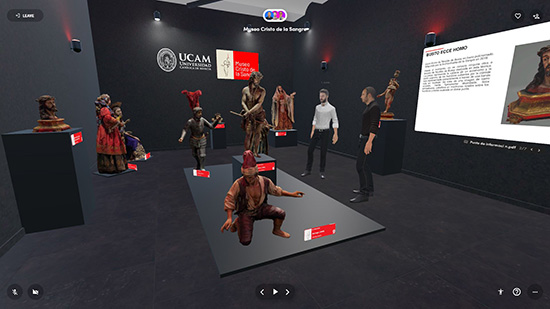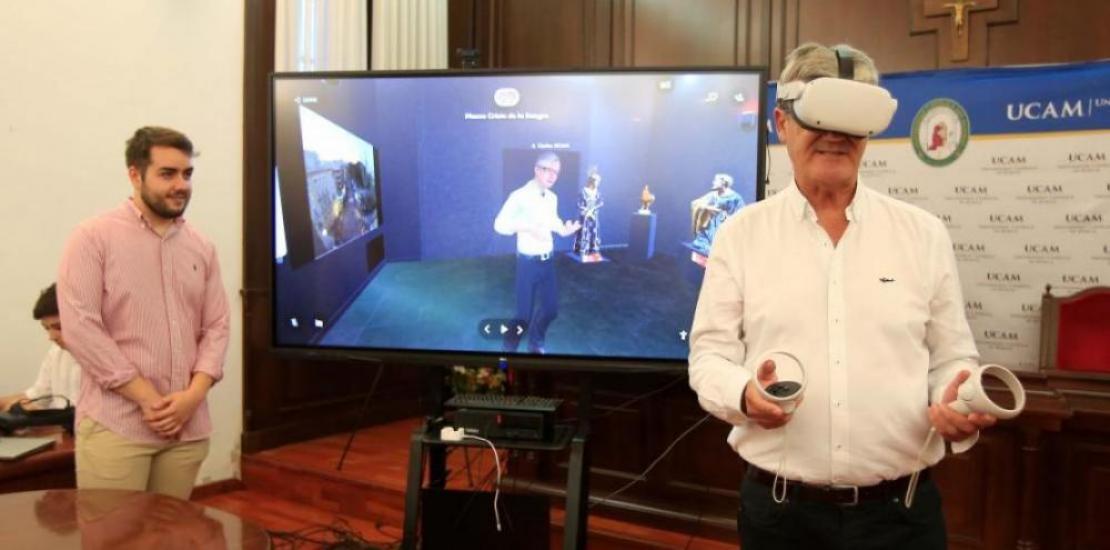The Cristo de la Sangre Museum enters the metaverse through a UCAM student
Miguel Alcaraz has completed the virtualisation of one of Museum’s rooms, with works by Nicolás De Bussy and Roque López. The result will be available to everyone visiting the website of the Archconfraternity (Archicofradía)
The world of culture in general and, in particular, museums is exploring the infinite possibilities of expansion that new technologies offer. The development of the metaverse offers experiences that were unthinkable until recently. And now, thanks to advances in devices and applications, they are a reality. A good example is the result of the Undergraduate Dissertation of Miguel Alcaraz, student of Telecommunication Technology Engineering at UCAM, who has virtualised one of the rooms of the Cristo de la Sangre Museum so that it can be visited in an immersive way. This is the first step in the metaverse in the field of heritage conservation in the Region of Murcia.
Once finished his dissertation, a demonstration of the end result was conducted, which will be available on the website of the Archconfraternity of the Most Precious Blood Museum . The virtual tour can be taken on computers, smartphones and tablets, but the novel and truly ground-breaking experience is the one offered by virtual reality glasses, as they allow the user to make the visit completely immersive and contemplate the works of Roque López, such as La Dolorosa (1787), or by Nicolás De Bussy, such as El Berrugo (1699) or La Negación (1689), almost as if they were standing in front of them. This is thanks to the use of photogrammetry, a technique that precisely defines the shape, dimensions and position of an object, using measurements made of several photographs of that object.
Miguel Alcaraz explains that it is about “the digitisation of cultural heritage, which is constantly at risk due to the passing of time or other circumstances, such as wars or natural disasters. We have created a high-definition digital environment for you to move around and get closer to the figures, to see them better and in more detail than ever before”.

Rafael Melendreras, Vice-Dean of the Bachelor's Degree in Telecommunications Technology Engineering, emphasised how “this is one of the many steps forward we have taken with the Archconfraternity of the Most Precious Blood. We are called to innovate in heritage conservation and that is why I encouraged Miguel to carry out this project, which is an open and accessible platform, as anyone with an Internet connection can access this product. The results of his work are outstanding”.
The first visitor to this virtual room was the president of the Archconfraternity, Carlos Valcárcel, who was impressed after experiencing the museum room with the virtual reality glasses: “I really didn't know if it was the original room of the museum, because it is an exact replica. The images have the same proportion, the same volume as they have in the real room. I think it's a great way to export, preserve and share this kind of religious imagery art, as people from all over the world can enjoy it without having to travel”.
A University involved in Digital Transformation
The result of the Undergraduate Dissertation by Miguel Alcaraz is not an isolated case at UCAM, as the institution has been immersed, for some time now, in a profound process of Digital Transformation, both in the academic and management spheres. Pau Guardiola, director of the Department of User Experience and Multimedia, recalled that UCAM “is at the forefront in technology, offering the best educational resources to our students, and this project is part of the process in which we work on artificial intelligence, cybersecurity or the educational metaverse”. He added: “We have developed experiences in Medicine, Sports Science or Dentistry that take advantage of this technology and have great potential in the cultural and educational fields”.




